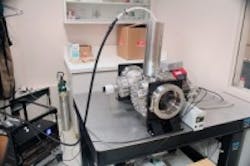MIT and Massachusetts General Hospital developing new X-ray imaging technology
A DARPA-funded joint project between MIT and Massachusetts General Hospital (MGH) could provide detailed X-ray images of soft tissue without the need for contrast agents or exceedingly expensive hardware.
The new approach works by producing coherent beams of X-rays from an array of micron-sized point sources, instead of a spread from a single, large point, as in conventional systems, says Luis Velásquez-García, a principal research scientist at MIT’s Microsystems Technology Laboratories and senior author of the PowerMEMS research paper, which won an award for Best Proceedings Paper. The team also created a specialized nanostructured surface with an array of tiny tips, each of which can emit a beam of electrons. The beams then pass through a microstructured plate that emits a beam of X-rays, according to MIT.
Current X-ray systems show little or no structure in most soft tissues. Coupled with a particle accelerator, an x-ray system was able to produce images of visible structures, lens, and cornea from an eye from a cadaver in a test, but this requires the use of extraordinarily expensive hardware. The new system would would ideally achieve the same resolution with a simpler and cheaper device, according to Velásquez-García.
The team used the prototype of the system to capture high-resolution absorption images of samples where fine soft tissue structures are clearly visible. Velásquez-García explains that the X-ray beams produced by the system are equivalent to something that can currently only be produced by an incredibly expensive systems (linear particle accelerators), but the new system "potentially improve the resolution of X-ray imagery by a factor of 100 with hardware that costs orders of magnitude less."
Benefits from producing images of this resolution include revealing the presence of a cancerous tumor by showing the details of the blood vessels supplying it, or revealing ligaments, muscle attachments, and details of bone structures of a knee X-ray, which cannot be seen on conventional X-rays. In addition, the new system would require a lower dose of radiation to the patient because it is electronic instead of thermionic.
The team expects to spend two to three years further developing the system and improving the design, and from there, Velásquez-García hopes to see commercial versions available within a few years after that.
In addition to Velásquez-García, the project included MIT postdoc Shuo Cheng, Rajiv Gupta of MGH, MIT postdoc Frances Hill, and MIT graduate student Eric Heubel.
View the press release.
Also check out:
Five examples of innovative medical imaging techniques
(Slideshow) The 12 months of vision: A holiday review of the year in machine vision
Camera module and image processor device aids visually impaired
Share your vision-related news by contacting James Carroll, Senior Web Editor, Vision Systems Design
To receive news like this in your inbox, click here.
Join our LinkedIn group | Like us on Facebook | Follow us on Twitter | Check us out on Google +
About the Author

James Carroll
Former VSD Editor James Carroll joined the team 2013. Carroll covered machine vision and imaging from numerous angles, including application stories, industry news, market updates, and new products. In addition to writing and editing articles, Carroll managed the Innovators Awards program and webcasts.
